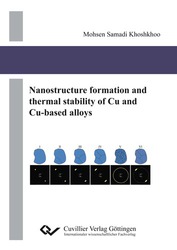| Fachbereiche | |
|---|---|
| Buchreihen (96) |
1378
|
| Nachhaltigkeit |
3
|
| Gesundheitswesen |
1
|
| Geisteswissenschaften |
2364
|
| Naturwissenschaften |
5406
|
| Mathematik | 229 |
| Informatik | 319 |
| Physik | 980 |
| Chemie | 1363 |
| Geowissenschaften | 131 |
| Humanmedizin | 243 |
| Zahn-, Mund- und Kieferheilkunde | 10 |
| Veterinärmedizin | 108 |
| Pharmazie | 147 |
| Biologie | 835 |
| Biochemie, Molekularbiologie, Gentechnologie | 121 |
| Biophysik | 25 |
| Ernährungs- und Haushaltswissenschaften | 45 |
| Land- und Agrarwissenschaften | 1004 |
| Forstwissenschaften | 201 |
| Gartenbauwissenschaft | 20 |
| Umweltforschung, Ökologie und Landespflege | 148 |
| Ingenieurwissenschaften |
1793
|
| Allgemein |
98
|
|
Leitlinien Unfallchirurgie
5. Auflage bestellen |
|
Erweiterte Suche
Nanostructure formation and thermal stability of Cu and Cu-based alloys
Mohsen Samadi Khoshkhoo (Autor)Vorschau
Leseprobe, PDF (2,6 MB)
Inhaltsverzeichnis, PDF (570 KB)
Nanostructured materials are materials with grain size smaller than 100 nm. Due to the very small grain size, a large fraction of atoms belong to the grain-boundaries. As a result, their properties are significantly different compared to their coarse-grained counterparts. Generally, a considerable improvement in the properties is observed when the size is reduced to nanometer dimensions. These include high strength and hardness, improved ductility and toughness, as well as enhanced diffusivity, which make this category of materials of particular interest for a wide range of applications. The properties of nanocrystalline materials are strongly affected by their structure and defects density, which in turn are determined by the method of production. As a result, the knowledge of the mechanism of nanostructure formation is a prerequisite for the structure/property optimization.
| ISBN-13 (Printausgabe) | 9783954048458 |
| ISBN-13 (E-Book) | 9783736948457 |
| Buchendformat | A5 |
| Sprache | Englisch |
| Seitenanzahl | 142 |
| Umschlagkaschierung | matt |
| Auflage | 1. |
| Erscheinungsort | Göttingen |
| Promotionsort | Dresden |
| Erscheinungsdatum | 12.01.2015 |
| Allgemeine Einordnung | Dissertation |
| Fachbereiche |
Physik
|








